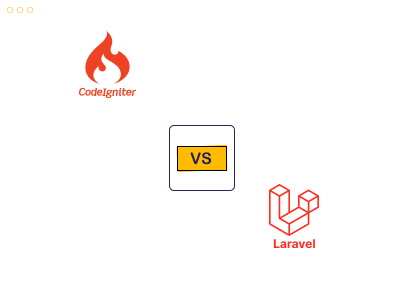Whenever we think about websites, development, and top web hosting solutions, having thoughts for the best web development frameworks is quite often. Even the discussion of the best PHP frameworks leads us to the two giants that stand out: CodeIgniter vs. Laravel.
PHP frameworks play an important role in web development, and both CodeIgniter and Laravel have become staples in web development, powering thousands of websites and applications around the globe. They provide developers with a solid base upon which scalable and efficient application construction can occur.
But when it’s time to choose between the two, how do you know which one is right for your project? Confusing question, right? Well, worry not, dear readers, This blog will go deeper into the key features, strengths, and limitations and discover the difference between Laravel and CodeIgniter. Ultimately, you’ll be able to make a smart choice that fits best with your development goals.
Table of Content
What Is CodeIgniter? An Overview
This is a PHP framework launched by EllisLab in 2006, though today it is supported by the British Columbia Institute of Technology. When we compare the CodeIgniter vs. Laravel performance, CodeIgniter comes as an extremely light, user-friendly framework. Moreover, it is ideal for developers on the quest to find an easy toolkit for creating full-featured web applications. The framework operates on MVC architecture and, most importantly, provides high-quality documentation, so it is best suited for beginners or mission-critical projects that require rapid development cycles.
Best CodeIgniter In-Built Tools
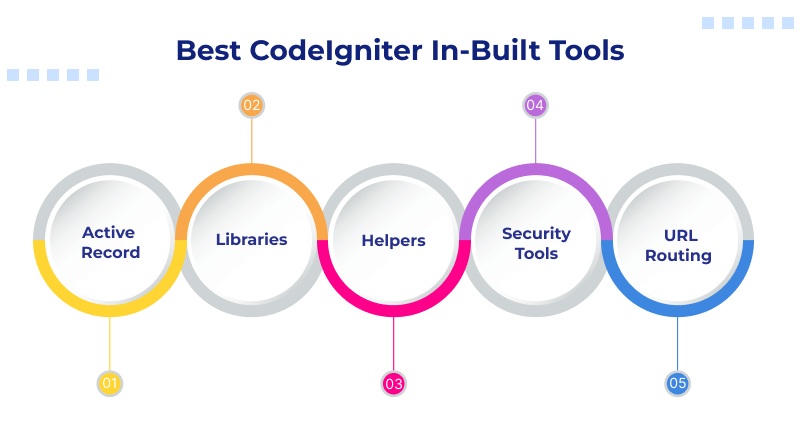
– Active Record
It is a basic abstraction layer for the database through which multiple layers can be created.
– Libraries
There are pre-programmed libraries available for common functionalities like form validation, sending emails, session management, etc.
– Helpers
It is a set of utility functions, mainly used for general functionality like date and time formatting, file manipulation, text processing, etc.
– Security Tools
CodeIgniter covers security features like CSRF protection, XSS, and SQL injection.
– URL Routing
The routing system can be very adaptive in mapping URLs to controller methods.
CodeIgniter Wikipedia
| Features | Description |
| Original author(s) | EllisLab |
| Developer(s) | British Columbia Institute of Technology (2014–2019), CodeIgniter Foundation [1] (2019-now) |
| Initial release | February 28, 2006 |
| Repository | CodeIgniter 3.XX Repository, CodeIgniter 4.XX Repository |
| Written in | PHP |
| Operating system | Cross-platform |
| Platform | PHP 5.6.0+ (v3.1.11) and PHP 8.1 or newer (v4.XX) |
| Type | Web framework |
| License | MIT License |
| Website | codeigniter.com |
CodeIgniter Use Cases
CodeIgniter, with its efficiency, can handle small to medium-sized projects with optimal speed, simplicity, and rapid development cycles. It is also perfect for new developers who find rigid coding standards difficult.
- Small to medium-sized applications: CodeIgniter is ideal for small projects and has less rigid requirements because of its lightweight code and easy learning.
- Rapid prototyping: In CodeIgniter, the minimal setup and configuration allow the web application to come into existence very swiftly.
- APIs: Its support for RESTful APIs makes for mobile apps, single-page applications, or any other systems outside
- Modernization of legacy systems: It makes upgrading legacy PHP applications to a better maintainable and scalable framework possible.
- Simpler web applications: Given the ease of deployment and less complex use of code, it is effortless to develop simple web applications, such as a blog, a forum, or a landing page. Further, with the best hosting for CodeIgniter, you can take your applications to higher levels.
CodeIgniter Use Cases Examples
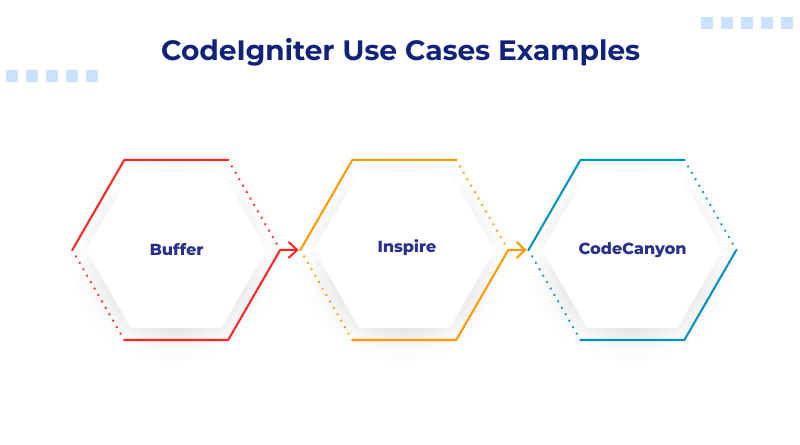
1. Buffer
The social media management platform, allowing users to schedule and analyze their content on social media.
2. Inspire
Popular design inspiration site with carefully curated collections of design resources and examples.
3. CodeCanyon
Marketplace for downloadable digital products, including PHP scripts, themes, and templates.
What Is Laravel? An Overview
Laravel is one of the top-notch and most widely-used PHP frameworks developed by Taylor Otwell way back in 2011. Though it follows the same architecture as CodeIgniter, it is a bit more focused on making an application look elegant and developer-friendly. Laravel comes with inbuilt features like authentication, routing, and Object-Relational Mapping (ORM) through Eloquent that gives all-in-one solutions to build web applications.
Best Laravel In-Built Tools
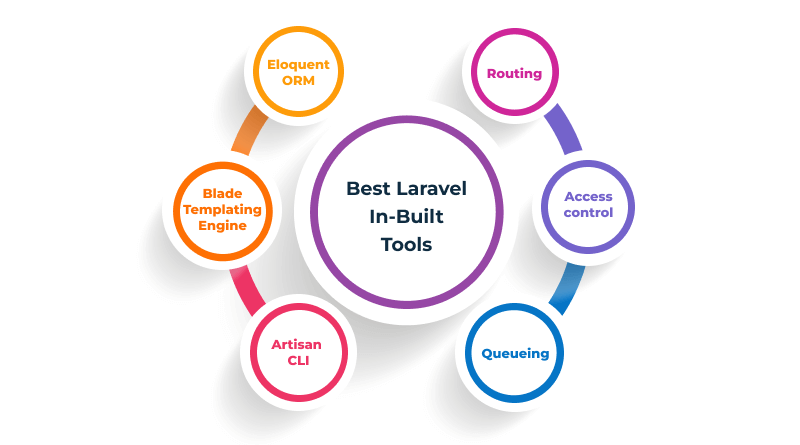
– Eloquent ORM
Object-relational mapper for working with models and relationships in the database is so much easier.
– Blade Templating Engine
lightweight and powerful templating engine for using conditional statements and loops, including dynamically rendered views.
– Artisan CLI
the command-line interface for managing tasks, generating codes, running migrations, and managing dependency relationships automatically.
– Routing
It’s a route system, quite flexible to define routes by HTTP method and URL pattern.
– Authentication and Authorization
User authentication and authorization are built-in using password hashing, session management, and role-based access control.
– Queueing
This makes an application more responsive by running the time-consuming operations asynchronously; therefore, forming a part of the queueing system.
Laravel Wikipedia
| Features | Description |
| Developer(s) | Taylor Otwell |
| Initial release | June 2011 |
| Repository | github.com/laravel/framework |
| Written in | PHP |
| Type | Web framework |
| License | MIT License |
| Website | laravel.com |
You may also find the Laravel vs. PHP concept a bit confusing, but worry not; read our detailed blog: Laravel vs. PHP: Comparing Frameworks, Pros, Cons, and Use Cases.
Laravel Use Cases
Laravel is the ideal choice for large and complex applications, especially when you want built-in features such as authentication, roles for users, and APIs. Its developer-friendly environment helps it to catch the attention of many developers in making high-quality, scalable apps with all modern features.
- Complex applications: Because of the numerous features and modular structure of Laravel, it is highly chosen for building complex enterprise-level applications.
- E-commerce platforms: A strong authentication system, an ecosystem of packages, and a template engine are some great things with which one can create a feature-rich e-commerce platform. In addition to better development, get reliable eCommerce hosting solutions for better results.
- CMS: Custom CMS development needs the ability to be flexible and extendable. Therefore, Laravel marks this difference between CodeIgniter and Laravel, becoming the suitable choice for CMS development methods. Moreover, getting top-class managed Laravel hosting solutions will boost the power of the overall CMS deployed.
- Social networking application: Laravel supports scalable social networking applications through its authentication, user management, and real-time capabilities.
- Enterprise resource planning: Laravel can be used to implement the complex workflow and integration required in enterprise resource planning systems.
Laravel Use Cases Examples
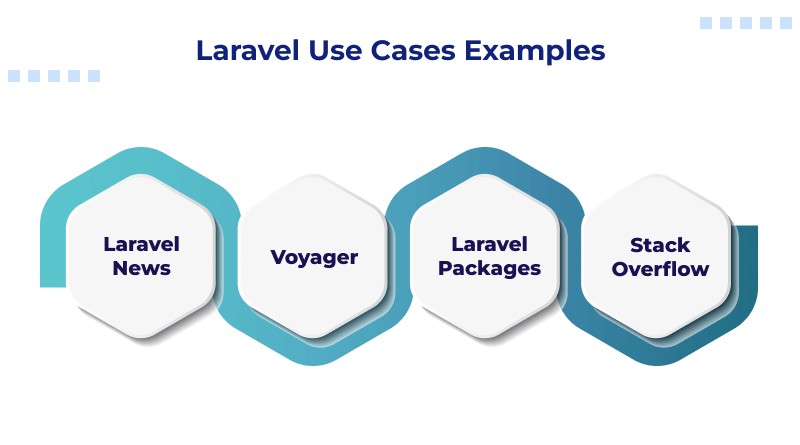
1. Laravel News
An online news resource for developers of Laravel, providing news, tutorials, and resources to aid in smooth development.
2. Voyager
A popular, open-source admin panel for Laravel, which allows it to smoothly manage content and applications with a friendly interface.
3. Spatie Laravel Packages
A collection of top-notch, high-class Laravel packages, including tools for SEO, media libraries, and much more.
4. Stack Overflow (partially)
The question-and-answer platform, where programmers using Laravel for parts of its infrastructure share their knowledge and expertise.
CodeIgniter vs. Laravel: Key Features
| Features of CodeIgniter | Features of Laravel |
| CodeIgniter has been developed on a light, overhead-free framework that guarantees fast performance with minimal resource consumption. | Laravel has beautiful syntax, making code writing extremely easy and enjoyable for developers. |
| Its structure is transparent and therefore acceptable to developers of all skill levels. | The authentication, routing, sessions, and Eloquent ORM are part of Laravel, built into the same so reducing third-party integrations. |
| Developers can easily modify and extend the framework for specific project needs. | It has a nice environment covering Laravel Forge for server management, Laravel Vapor for serverless deployment, and Laravel Mix for asset compilation. |
| CodeIgniter has an active community that, besides providing many resources such as forums and tutorials, really gets users off on the right foot when building or completing applications. | Laravel focuses on developer happiness through clean documentation and easy debugging tools. |
Difference between Laravel and CodeIgniter
| Advantages of CodeIgniter | Advantages of Laravel |
| Easy-to-Setup and Learn: CodeIgniter brings easy getting started with a simple approach without any complex setup and learning curve. | Feature-rich: Laravel comes with a wide range of in-built features that would otherwise be a heavy task to build from scratch for the majority of common functionality. |
| Fast: It is lightweight in nature with quick load times and resource management. | Massive Community and Ecosystem: The community is wildly large with thousands of packages, tutorials, and extensions. |
| Flexible: Does not adhere to any specific coding standards; thus, you can code your thing. | Modern and Scalable: With caching, database migration tools, and job queues, Laravel is well-built for scaling. |
| Disadvantages of CodeIgniter | Disadvantages of Laravel |
| Fewer Built-In Features: Although this is an advantage of CodeIgniter, it really offers several built-in features that much more modern frameworks do. | Performance: It’s generally slower than some lighter frameworks like CodeIgniter owing to its feature-rich characteristics. |
| Less Innovative Technology: To some, CodeIgniter doesn’t comply with modern trends in web development. | Steep Learning Curve: This framework requires a huge amount of time to learn since it has many features. |
| Not Very Modern Package Ecosystem: While compared to Laravel, there aren’t many third-party tools and packages available. | Overhead for Small Projects: Because of its great features, it becomes a bit overkill for very small applications. |
CodeIgniter vs. Laravel: A Comparison
- Performance: CodeIgniter vs. Laravel performance is considered; no doubt CodeIgniter performs better since it is pretty lightweight and resource-intensive. Laravel, being powerful, generates much overhead due to the presence of highly complex features. However, with modern web applications and complex needs, in most cases, it is fine to compromise on the performance of the provided features of Laravel.
- Learning Curve: Among code igniter vs. Laravel, the learning curve too determines the user’s and web developer’s preference. CodeIgniter is very easy to learn, even for a beginner. However, in the case of Laravel, due to the richness of the feature set, you have to go with the technicalities and learn more. But if you take a look at Laravel’s vast documentation and large community support, you can get started with its learning process easily.
- Scalability: Confused between CodeIgniter or Laravel for scalability? Both are scalable; however, Laravel is more suitable for big projects. It can manage even huge applications more conveniently because of features like queues, caching, and native support for an API. Although CodeIgniter is scalable, it requires more customizations, and sometimes the use of third-party tools is desired to achieve similar scalability.
- Community Support: Laravel has a much more extensive ecosystem than CodeIgniter. It uses first-party tools like Forge and Vapor, together with a huge collection of packages available through Packalyst. In contrast, the CodeIgniter ecosystem is much smaller in size, with a design focused on simplicity and fewer dependencies.
CodeIgniter vs Laravel are both fantastic PHP frameworks, with their own strengths and the best suitability for certain cases. On such strength, CodeIgniter can be perfect for projects requiring simplicity, speed, and flexibility. It is best suited for beginner-friendly applications or small-sized applications. In contrast, Laravel is great at providing a rich set of features, robust security, and community support.
Both of the frameworks have lots of inbuilt tools that could help build an efficient framework for development and enhance the performance of the application. The best one between the two depends on your specific project needs and preferences.
CodeIgniter performs very well when it comes to performance and speed with simplicity. Laravel works great on larger and more complex projects, considering it is modern and has a powerful feature built-in.
FAQs
How does CodeIgniter compare to Laravel in terms of performance?
For CodeIgniter vs. Laravel performance, CodeIgniter processes and functionalities coding back-end generally faster than that of the comparatively new Laravel. Still, the two frameworks can be configured and coded to achieve improved performance.
On the other hand, Laravel is a little slower compared to CodeIgniter. It tends to give rather more advanced techniques for improving performance like caching, query optimization, and lazy loading that may permit even better performance in certain scenarios.
Is CodeIgniter suitable for large-scale projects?
While you can try to develop large projects with CodeIgniter, it might not be the best go-to option. The major difference between CodeIgniter and Laravel is the varied size of project development. Laravel is the ideal suit for huge projects with its modularity and number of features. In addition to that, it has a robust community base and provides more scalable, maintainable, and testable complex applications.
Which is easier to learn: CodeIgniter or Laravel?
CodeIgniter is often easier to learn for newcomers because of its easy syntax and minimal configuration. On the contrary, Laravel is steeper since it has all the complex features and makes extensive use of object-oriented concepts, but it has excellent documentation and a large community to support the learning journey for beginners.
Which is more secure: CodeIgniter or Laravel?
Among CodeIgniter vs. Laravel security measures, Laravel takes the lead. CodeIgniter only provides basic security features but needs more configuration and third-party libraries to have much more security for large applications. However, with Laravel, security features such as CSRF protection, SQL injection prevention, and XSS protection are inbuilt. Hence, web developers get security by default. It has a huge community where it benefits from even active contributions toward security improvements.

